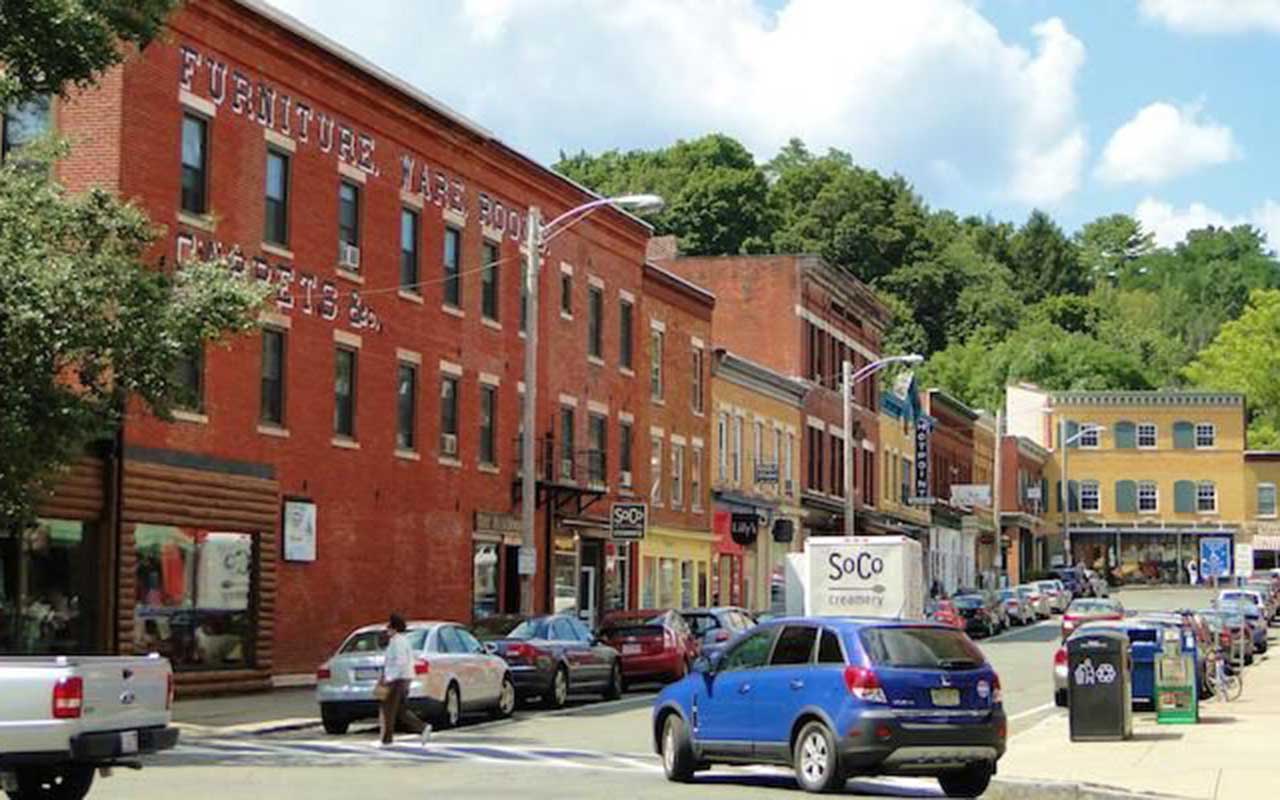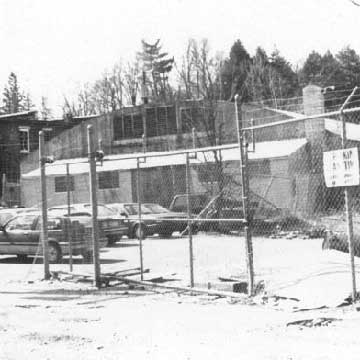This Month’s Featured Article

The Renaissance
 To be at the intersection of Railroad and Main Streets in Great Barrington, MA, today is, for people who know the history of the town, like being at the graduation of one’s child from a Master’s Degree program. Thirty years ago, today’s scene was a dream and a plan.
To be at the intersection of Railroad and Main Streets in Great Barrington, MA, today is, for people who know the history of the town, like being at the graduation of one’s child from a Master’s Degree program. Thirty years ago, today’s scene was a dream and a plan.
Today, the storefronts are occupied with eclectic and traditional businesses; restaurants and coffee shops abound; the sidewalks are spacious and well taken care of; pedestrian crosswalks are clearly marked and respected; and – what it’s really all about – there are people everywhere. Even for tourists, this multitude of positive impressions generates a palpable sense of prosperity and cohesion. It’s a town that has its stuff together. It’s a graduate with a solid future. Truly, though, today’s success seemed as likely for this town as the achievement would be for the middle school ne’er-do-well whose teachers gave up on them. But a turn-around is always possible where there’s a vision and a community to support it.
Getting things started
Flash back to the late 1980s. Richard Stanley loved the Berkshires. Born in Brooklyn, raised on Long Island, and a professed “junkie of New York City” as an adult, he had a second home in nearby South Egremont. When he sold his business in Long Island, he moved to his second home full-time.
“I played golf for a year,” he said of this rare down time, “and I got into real estate. I always thought Great Barrington was a hub for the southern Berkshires. I decided to purchase the Barrington House in the center of town, which was in disrepair. As I renovated the building,” he said, “I became more interested in the town and what was going on there. I joined the Southern Berkshire Chamber of Commerce. It was clear the town was at a crossroads.”
Hank Ervin grew up in North Carolina and spent summers as a teen working at a camp in the Berkshires, which is where he developed his love of the area. After college, he worked in Boston, eventually moving to Pittsfield with his wife. His position with First Agricultural Bank put him squarely in the circle of those who could make a difference in the southern Berkshires. Looking back to the early 1990s, he said, “Serendipity can be a strange thing. When I started at the bank I got involved with the Southern Berkshire Chamber of Commerce. The vacancy rate on Main Street in Great Barrington at that time was about 25%. There was no parking, and there was no money for parking. Along came a rep for the Massachusetts Department of Economic Development, asking me what could be done to help the area. I knew exactly who they should talk to.”
The prospect of grant monies that could lead to significant transformation of the downtown was exciting for many. Meetings were held to identify as clearly as possible Great Barrington’s significance to its population and also to its area. In the Main Street Revitalization Proposal drafted in 1992 to target grant monies, it was noted, in part,
“In response and recognition of the increasing retail-store vacancies and continued existence of numerous blighted structures, the Chamber of Commerce has held several open citizen participation forums… Participants discussed the current state of our Main Street, zoning issues, what direction should we take in developing Main Street, parking problems, disinvestments as well as utilization of empty buildings… people feel that the long-term survival of Main Street is linked to the long-term survival of the community… Main Street is one of our finest resources.”
Blight made things right
In the center of town was a trifecta of a mess: an abandoned old bowling alley, a burned-down lumber company, and the clear blight that they were generating. Stanley and others realized it would take much more than renovating just the Barrington House to make a lasting difference. The Revitalization Proposal made clear that: “The primary national objective of this activity is the ‘prevention or elimination of slums or blight.’… Specific attention will be for the creation of a DOWNTOWN PARTNERSHIP. The partnership will be charged with the specific responsibilities of Business retention, development and recruitment; Downtown Market Analysis; Tourism Development; and the critical need to develop an organizational structure to coordinate and implement the plans…”
In 1992, the Main Street Action Association (MSAA) was established as a division of the Southern Berkshire Chamber of Commerce under William (Bill) Webber III, with Michael Hogg serving as its President. Monies started coming in to pay for market analyses, traffic studies, staff, and supplies. Hogg and Stanley applied for additional monies to continue developing the blighted area, securing over $400,000 by writing grant proposals from the state Executive Office of Communities and Development.
Ervin noted, “In my discussions with EOCD, parking by and large was not considered an eligible purpose for the rear property at the Barrington House, so we brainstormed how we might wrap parking into a plan. The only way,” he said, “was to wrap the parking into a greater economic development plan. What started out as discussion about parking mushroomed into something much greater.”
Bob Raser remembers those days well. He owned the iconic Carr Hardware store on Main Street and was the President of the SB Chamber of Commerce, having served on the Board for years. “Great Barrington was indeed a hub of the Southern Berkshires,” he noted. “Under Musical Director Seiji Ozawa, Tanglewood (the music venue in nearby Stockbridge) was drawing more and more people from Boston and New York City,” he said. “The influx was starting, people were coming and wanting to stay, but Main Street was not seeing its potential.”
What this town needs…
With grant monies secured, the MSAA was still in planning stages for what to do with downtown. Ideas were bounced around. Business development, for sure, restaurants, shops, safe sidewalks, parking, but what else? It was Stanley’s conviction that a movie theater would be the ideal addition to this part of town. “I felt the town needed a ‘heart space,’” he said, “and a movie theater can do that. A movie theater is a destination,” he pointed out. “It gives people a reason to come down town. After, people typically want to talk about a movie, or they make a date out of going to the movies, so they’re looking for nearby restaurants. But the theater is what gets them here.”
“When Richard shared his vision,” Raser noted, “everything started to come together.”
Raser echoed Ervin’s comment about the serendipitous nature of what happened next: “The whole community came together for the good of the community,” he said. “Businesses, of course, but also service organizations, utilities like power and gas companies, schools, the general public, even politicians. Stanley was at the helm,” he noted, “and the community support was unparalleled. Everyone came together to make sure what needed to get done got done. One of those people was Pam Krol who owned Krol Jewelers, a Railroad Street staple. Considered a true “people person,” Krol was instrumental in helping bring everyone together. She was a founding member of the Railroad Street Merchants Association; she was a director in the Southern Berkshire COC; she was a true believer in BerkShares (more on that later); and she created what would go on to be the beloved town-wide Great Barrington Summerfest. She was a champion for the vision Stanley and others knew would transform the town. Sadly, Pam passed away just this past February.
Raser reflected, “There were over 50 businesses that needed to sign waivers for access to parking if this was going to happen. Imagine that.”
…is a movie theater!
The Triplex Cinema, Stanley’s and the town’s keystone for a place to bring people together, opened in November 1995 with nearby parking; large, clean sidewalks; and, sure enough, as Stanley believed, “because people were looking for them, restaurants started opening. Other businesses followed, and things started flowing. What influenced my intuition about this,” Stanley said, “was my experience in Manhattan. People go where it’s interesting – and safe – to be. And they come back.”
Under Stanley’s management, the Triplex focused on independent films that were hard to find in other places and that generated the kind of conversations people enjoyed having over coffee, drinks, or a meal. When the proposal came in the early 2000s for the Triplex to host an international film festival, Stanley didn’t hesitate. The Berkshire International Film Festival (BIFF), held annually the first week of June, is now another peacock feather in Great Barrington’s plume-studded hat.
Historical precedent
Gary Leveille is a historian and author of seven books on local history, including Legendary Locals of the Southern Berkshires (Arcadia Publishing, 2014). He writes Then and Now, a column on life in the Berkshires for the Berkshire Edge. Leveille is also an archivist for the Great Barrington Historical Society. After college he and some friends lived in a rental at the intersection of Railroad and Main Streets. He knows a thing or two about the history of Great Barrington and the Berkshires.
“Railroad Street had quite a history,” he shared. “In the 1920s through ‘40s it was full of bars and pool halls and gambling; it was seedy. Things started to improve in the 1970s and ‘80s,” he said, “but it still had a reputation, and long-time residents were wary of the area. Then along came Richard. He really had a vision,” he said.
“Great Barrington is a tight community,” Leveille said. “It has a history of supporting worthy causes. For example, it was the town that raised the money for W.E.B. DuBois to go to college.” DuBois was born in Great Barrington in 1868, and one can imagine the challenges for a Black family in the heart of New England at that time. His teachers and the community realized his potential, and they were not short-sighted. DuBois went on to earn a PhD from Harvard University in 1895. Among his lifetime of diverse accomplishments was sharing in the creation of the National Association for the Advancement of Colored People (NAACP) in 1909. He edited the organization’s magazine, The Critic, for over 20 years. His homesite is a National Historic Site in Great Barrington, another tourist destination.
“Richard was new to the town,” Leveille noted, “but he was persuasive and he persevered. When the cause is right, there’s always been community support here. Finding parking is a nice problem to have.”
A community of riches
Flash forward to the past few years. Great Barrington’s aptly recognized renaissance of the 1990s continues to play out in the town and community today. The Triplex continues to thrive, and there’s also the world-class Mahaiwe Performing Arts Center just a few blocks down on Castle Street. The theater, a three-story brick and marble complex, opened for live performances in 1905. Home to vaudeville, “talkies” and more consistently feature films, it was in a state of disrepair around the same time the Triplex opened, and its fate became unclear. In 2002, Lola Jaffe rallied supporters to form a non-profit to rehabilitate the space, and over nine million dollars later, the Mahaiwe Performing Arts Center opened its doors just in time for a Centennial Celebration in 2005. Today, the theater is home to a variety of performances and other events.
Stanley marvels at the “depth of community” in Great Barrington. He recognizes three top strengths for the town: 1) Diversity of population and experience; 2) opportunity for existing and new businesses; and 3) local food and restaurants that attract newcomers and regulars. “There’s a great sense of place in smaller towns,” he said, “and that needs to be paid attention to and fostered.”
Hank Ervin likes to point out the multiple success stories in and around Great Barrington. The Berkshire Food Co-Op, which started in someone’s garage in the late 1960s and is now in a prime Bridge Street location in a beautiful new space of nearly 10,000 square feet of grocery store and administrative space. It’s open daily 9am to 7pm. Ervin points to the Berkshire South Regional Community Center and the Railroad Street Youth Project as examples of organizations that support different segments of the population, equally necessary for the town’s overall vitality.
Local. Local. Local.
Stanley spoke enthusiastically about Susan Witt’s creation of BerkShares in the early 2000s. BerkShares are a currency that can be used at local businesses to keep dollars in the community. Backed dollar-for-dollar by local banks and businesses, paying for goods and services with BerkShares enforces a sense of local commitment. There’s even an app now so users can go paperless. Witt is a co-founder and now Executive Director of the Schumacher Center for a New Economics, based in Great Barrington.
Historian Gary Leveille includes among his favorite places in Great Barrington the Mason Library; the Great Barrington Historical Society Museum (“a gem”); and the Gorham & Norton grocery store – all of them on Main Street. “And the churches and architecture all over town,” he said.
You can do a Google search of Great Barrington and the Berkshires and find no shortage of articles and information praising the town and the area. In January of 2022, Kaitlyn Wylde wrote for Vogue Travel: “With a slew of new businesses that could easily thrive on a popular Brooklyn street – many of which actually did – and improvements to existing cultural institutions, Great Barrington has become one of the most popular destinations in the highlands of Massachusetts.”
Wow. Now.
Today, Stanley is the vice president of the Community Development Corporation of the Southern Berkshires (CDCSB), an organization he helped found. Its mission is “to create affordable housing and economic opportunity for low- and moderate-income households in the southern Berkshires.” This is more important than ever in the wake of the COVID pandemic, which saw many city dwellers escape to their second homes to reside permanently, and also younger families moving to the area. Real estate has become a super-hot commodity, and housing for downtown workers is at a premium. Housing, transportation, education, maintaining a town’s diversity while accepting and embracing that it’s trendy – these are worthy issues for a thriving town and area. Great Barrington in the next 5-10 years? “More of the same,” he mused.
If anyone likes a challenge, it’s Richard Stanley. If you like to visit towns that are a delight to explore, all roads lead to Great Barrington.



